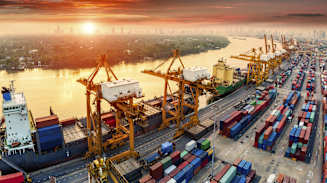Related Insights
-
Article
Reshoring: Managing Risks and Building Resilience Closer to Home
-
Capability Overview
Supply Chain Risk Management

On April 2, the White House announced sweeping global trade tariffs with wide-ranging implications for economies, financial markets and international businesses. These tariffs, which have been subject to change and are likely to further, are not only a shift in trade policy, but also a substantial contributor to financial volatility that organizations must navigate.
As businesses analyze their exposure to these tariffs, understanding their potential to disrupt operations and supply chains has become paramount. The effective management of this volatility will require a renewed focus on strategic risk management and robust decision making.
Aon is actively working with clients to assess the impact of these developments and stands ready to support informed, strategic decision making across five key considerations:
Tariffs inevitably create significant market volatility and uncertainty for businesses, particularly those with complex supply chains whose operations rely on the import and/or export of goods and materials across regions. These organizations may be prompted to focus on reshoring and realignment as trade tensions escalate.
Lee Meyrick, Aon’s Global Industry Specialty leader, emphasizes the complexities introduced by tariffs, stating, "The dynamic nature of tariffs can significantly disrupt trade. Increased costs can demand more procurement limitations, necessitating a nimble strategy. Moreover, the physical movements of goods are fraught with enhanced risks, as seen during crises in the Middle East, where diversions added millions in unnecessary shipping costs. Tariffs not only shape economic landscapes but also introduce complexities in logistics and strategy."
Aon is helping clients quantify the likely impact of these changes through its Supply Chain Risk Diagnostic Tool, as well as through solutions that go beyond traditional measures to help reduce volatility. Even with the best risk mitigation strategies in place, there are rare situations such as sanctions, embargos or an unwanted invasion that can result in severe disruptions to the normal course of business. These circumstances require solutions that go beyond traditional measures to help create stability, including trade credit insurance, political risk insurance and trade disruption insurance.
Aon's Marine Risk Engineers and Loss Control teams play a crucial role in helping organizations understand risks associated with the movement of goods. They support clients in developing strategies to mitigate these risks, particularly in an environment characterized by heightened uncertainty and dynamic tariff measures.
Risk mitigation strategies can include:
“Organizations need insights that help them proactively understand and potentially mitigate tariff risks. This approach is particularly useful for companies that might not fully understand their exposure across their entire supply chain,” says Richard Waterer, Aon’s Global Risk Consulting CEO.
Article
Reshoring: Managing Risks and Building Resilience Closer to Home
Capability Overview
Supply Chain Risk Management
Markets across the globe have fallen sharply in response to President Trump’s tariffs announcement. The trading environment remains uncertain, with implications for retirement plans, pensions and broader financial wellbeing. Organizations need to specifically consider how they communicate these implications to colleagues nearing retirement.
For trustees, Aon is advising investors to consider alternative asset classes such as selected low-beta hedge funds, which can provide resilience during stock market volatility. Additionally, asset classes with high expected returns but low correlation to equity markets, like insurance-linked securities, are recommended.
This could also be a good time for plan sponsors to consider the benefits of pooled or master trust solutions. These can be particularly helpful to mitigate and offload fiduciary risks during market volatility. Periods of volatility tend to be when litigation in retirement plans is highest — with claims of mismanagement of plan investments and other plan offerings and features. Lastly, the benefits of outsourcing inherent in these arrangements can also allow organizational leaders to stay more focused on the core business without the distractions associated with the fiduciary oversight of retirement plans.
Despite recent falls in yields, corporate defined benefit investors should consider bringing forward their hedging increases. Gilts have occasionally reached yields that look attractive for growth-invested investors, such as non-profits, defined contribution schemes and other institutional investors. Appropriate allocations depend on overall asset allocation and investment objectives.
Economists expect inflation to rise with widespread tariffs. Employers should look for ways to support their employees’ financial wellbeing through tailored guidance and education, particularly for employees nearing retirement age. This includes guidance for employees considering borrowing against their 401(k) plan in the U.S.
Article
A Comprehensive Approach to Financial Wellbeing
Capability Overview
Pensions and Retirement
Tariffs will encourage U.S. businesses to reshore their manufacturing and research and development (R&D) base, while also pushing some international firms to establish or deepen their U.S. footprint. While strategic considerations will dominate this decision making, tariffs could have implications for international people mobility and reskilling. Trade tariffs will encourage the repatriation of U.S. citizens sent overseas to develop manufacturing, R&D and operational capabilities in other territories, as well as the assignment of international staff intimately familiar with overseas operations to the U.S. These individuals will likely need to acquire new skills and adapt. Tariffs could also lead to new trade alliances. For example, China, Japan and South Korea recently announced they intend to accelerate negotiations on their free trade agreement. All of these changes could impact companies’ location and hiring strategies.
Aon is supporting clients in developing their global mobility strategies through flexible employee benefit programs, compensation and rewards benchmarking, and dedicated insurance solutions. Additionally, we help clients design and implement workforce skills frameworks that enable organizations to identify and acquire essential competencies for business success, including internal skills that may mitigate recruitment costs.
Report
International People Mobility Report
Capability Overview
Workforce Skills
During tariff uncertainty, organizations should adapt their perspective on risk management and insurance. Traditionally, the instinctive response may have been to scrutinize insurance costs; however, now is the time to understand insurance as a crucial mechanism for volatility suppression.
It is essential for organizations to quantify risks thoroughly and optimize the performance of their insurance structures. This will ensure they are delivering maximum volatility suppression as the economic uncertainty created by tariffs roils the markets.
Aon provides in-depth expertise in global markets and risk analytics to help clients navigate this evolving landscape. Our focus is on identifying optimal solutions for evolving risk profiles — emphasizing the necessity for informed, strategic decisions regarding risk management.
Sean Rider, Aon’s head of risk analytics for Commercial Risk in North America, emphasizes the importance of acknowledging the impact of tariffs on financial stability, stating, "Organizations need to understand that the impulse to cut insurance costs may actually increase their exposure to financial volatility. Instead, this is the time to invest in optimizing risk finance, exploring alternative strategies and maximizing the de-risking available in insurance markets. Your budget for volatility is now wholly consumed by the current economic turmoil. Now is not the time to pile-on by taking on modellable, otherwise insurable volatility.”
Article
5 Key Risk Capital Trends to Watch in 2025
Capability Overview
Broking and Risk Transfer
Tariffs are anticipated to increase prices for American households — at least in the short term — forcing them to make choices about spending. Medical costs are already projected to rise 10 percent globally and 9 percent in the U.S. in 2025. This may be one area where employees are forced to reduce spending as a result. In the U.S., many critical components the health system, from drug ingredients to durable medical components, are sourced abroad and have a long and complex supply chain. While there is a lot of uncertainty about the impact to costs and whether some components can be shifted to local production, employers should remain focused on managing high-cost claims, advising plan members of cost-effective and quality providers and other value-led strategies.
Aon’s proprietary analytics and algorithms assess data around employee health information, insurance claims, workplace safety and engagement metrics, as well as non-traditional data such as program management. This provides the insight needed to optimize benefit investments and improve health outcomes.
Our benefits benchmarking and consulting services help employers understand how competitive their health and benefits offerings are, how their cost drivers and health outcomes compare to their peers, opportunities to improve and strategies for taking a value-led approach. Aon’s Health Risk Analyzer leverages analytics and machine learning to forecast future medical and pharmacy claims risk within an organization.
Article
Value-Led Approaches to Reduce Healthcare Costs in the U.S.
Capability Overview
Health and Benefits
Our Better Being podcast series, hosted by Aon Chief Wellbeing Officer Rachel Fellowes, explores wellbeing strategies and resilience. This season we cover human sustainability, kindness in the workplace, how to measure wellbeing, managing grief and more.
Expert Views on Today's Risk Capital and Human Capital Issues
Expert Views on Today's Risk Capital and Human Capital Issues
Expert Views on Today's Risk Capital and Human Capital Issues
The construction industry is under pressure from interconnected risks and notable macroeconomic developments. Learn how your organization can benefit from construction insurance and risk management.
Stay in the loop on today's most pressing cyber security matters.
Our Cyber Resilience collection gives you access to Aon’s latest insights on the evolving landscape of cyber threats and risk mitigation measures. Reach out to our experts to discuss how to make the right decisions to strengthen your organization’s cyber resilience.
Our Employee Wellbeing collection gives you access to the latest insights from Aon's human capital team. You can also reach out to the team at any time for assistance with your employee wellbeing needs.
Explore Aon's latest environmental social and governance (ESG) insights.
Our Global Insurance Market Insights highlight insurance market trends across pricing, capacity, underwriting, limits, deductibles and coverages.
How do the top risks on business leaders’ minds differ by region and how can these risks be mitigated? Explore the regional results to learn more.
Our Human Capital Analytics collection gives you access to the latest insights from Aon's human capital team. Contact us to learn how Aon’s analytics capabilities helps organizations make better workforce decisions.
Explore our hand-picked insights for human resources professionals.
Our Workforce Collection provides access to the latest insights from Aon’s Human Capital team on topics ranging from health and benefits, retirement and talent practices. You can reach out to our team at any time to learn how we can help address emerging workforce challenges.
Our Mergers and Acquisitions (M&A) collection gives you access to the latest insights from Aon's thought leaders to help dealmakers make better decisions. Explore our latest insights and reach out to the team at any time for assistance with transaction challenges and opportunities.
How do businesses navigate their way through new forms of volatility and make decisions that protect and grow their organizations?
Our Parametric Insurance Collection provides ways your organization can benefit from this simple, straightforward and fast-paying risk transfer solution. Reach out to learn how we can help you make better decisions to manage your catastrophe exposures and near-term volatility.
Our Pay Transparency and Equity collection gives you access to the latest insights from Aon's human capital team on topics ranging from pay equity to diversity, equity and inclusion. Contact us to learn how we can help your organization address these issues.
Forecasters are predicting an extremely active 2024 Atlantic hurricane season. Take measures to build resilience to mitigate risk for hurricane-prone properties.
Our Technology Collection provides access to the latest insights from Aon's thought leaders on navigating the evolving risks and opportunities of technology. Reach out to the team to learn how we can help you use technology to make better decisions for the future.
Trade, technology, weather and workforce stability are the central forces in today’s risk landscape.
Our Trade Collection gives you access to the latest insights from Aon's thought leaders on navigating the evolving risks and opportunities for international business. Reach out to our team to understand how to make better decisions around macro trends and why they matter to businesses.
With a changing climate, organizations in all sectors will need to protect their people and physical assets, reduce their carbon footprint, and invest in new solutions to thrive. Our Weather Collection provides you with critical insights to be prepared.
Our Workforce Resilience collection gives you access to the latest insights from Aon's Human Capital team. You can reach out to the team at any time for questions about how we can assess gaps and help build a more resilience workforce.

Article 4 mins
Organizations can demonstrate their commitment to global sustainability and a low-carbon future by addressing verification challenges and adopting best practices.

Article 15 mins
Market stability prevails in management liability lines as insurers continue to seek market share. However, expanding technologies, increased litigation and macroeconomic factors are causing growing uncertainty and underwriting concerns.

Article 7 mins
There is an opportunity to develop a strategy around financial education in the workplace. Globally, our latest data finds 11 percent of employees receive financial education from their employer, but 37 percent expect it. How can employers bridge this gap?